| Article ID | Journal | Published Year | Pages | File Type |
|---|---|---|---|---|
| 1397346 | European Journal of Medicinal Chemistry | 2014 | 12 Pages |
•N,N′-Bis(salicylidene)-(±)-trans-1,2-diaminocyclohexane (saldach) as scaffold.•Imidazolium salts (Im+–R2R3–Cl−) covalently attached to H2(R1)2 saldach backbone.•Compounds were tested against four bacterial pathogens and two fungal strains.•Most compounds showed promising antibacterial activity.•H2(tBu)2saldach(Im+–HMe–Cl−)2 and its Fe-complex are possible antibiotic candidates.
Imidazolium salts (Im+–R2R3–Cl−) attached to the N,N′-bis(salicylidene)-(±)-trans-1,2-diaminocyclohexane (saldach) backbone (4a–f) have been designed and successfully applied for the synthesis of the corresponding mononuclear complexes with Mn(III) and Fe(III) ions. The molecular structures of the saldach ligands H2(R1)2saldach(Im+–R2R3–Cl−)2 (R1 = H, tert-Bu, R2 = H, Et, n-Bu, R3 = H, Me) and their [M(III)Cl{(R1)2saldach(Im+–R2R3–Cl−)2}] (M = Mn, Fe) complexes have been established. The free ligands exist as the phenol-OH and not as the zwitterionic (imine)N–H+···−O(phenol) tautomer. Antimicrobial activity of the target compounds revealed higher potent antibacterial activity against Salmonella aureus, B. subtilis while less effective against E. coli and C. albicans and inactivity against A. flavus. Compound (4d) and its Fe(III) complex (6d) exhibit remarkable extra-potent bactericidal activity.
Graphical abstractA novel synthetic strategy has been successfully developed for the synthesis of saldach–imidazolium derivatives and their complexes. These compounds represent promising candidates when set in the context of antimicrobial applications.Figure optionsDownload full-size imageDownload as PowerPoint slide
